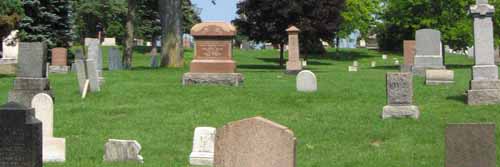
The Hamilton Cemetery at 777 York Boulevard in Hamilton is the final resting place for many famous Hamiltonians. This cemetery was originally three separate but adjacent cemeteries. Christ Church Anglican Cemetery was the first in 1847.
The Burlington Heights Cemetery was established by the city of Hamilton in 1848. The Church of the Ascension (Anglican) Cemetery had its first interment in 1851. However, it was almost the turn of the century before the three agreed to amalgamate to form the Hamilton Cemetery.
The Hamilton Tour
Robin McKee’s tours of the Hamilton Cemetery not only provide information about the topography and earlier history of the cemetery area, a tract of almost 100 acres, but provide a framework for the history of our community.
The cemetery contains reminders of some of the public and private tragic events that have marked the community’s history (e.g. the great Cholera and Influenza epidemics, the Desjardins Canal Disaster and the burials of war veterans).
While some tours have a specific theme or focus you will almost certainly learn many things that you did not know about the Hamilton community and its citizens through the past 150 years.
The objective of a cemetery tour is not simply to visit grave sites and read headstones.
Robin McKee has interesting stories to tell about the lives of those who are buried there and the contributions that they have made to our community. He is knowledgeable about local history and welcomes questions. Always keen to exchange information with anyone interested in the history of the Hamilton area.
Prominent Leaders Buried in Hamilton Cemetery
Many prominent civic and community leaders are buried in the Hamilton Cemetery. These include:
- Robert Land, Sr., one of the first settlers in the Hamilton area.
- George Hamilton, from whom the City takes its name.
- Colin Campbell Ferrie, Hamilton’s first mayor.
- Charles Magill, who served as mayor of Hamilton for six one-year terms (the first in 1854 and the last in 1883).
- James Gage, whose home has been preserved as Battlefield House Museum in Stoney Creek.
- Dr. Calvin McQueston, whose residence in Hamilton (“Whitehern”) has been designated a National Historic Site.
- Col. William Winer Cooke, the only Canadian to die at the battle of the Little Big Horn with General Custer.
- Adelaide Hoodless, social reformer and founder of the Woman’s Institute.
 | Daniel of the Web
| Daniel of the Web